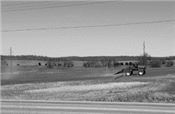Aphids Not Detected In Wheat Fields In Western Kentucky Yet

Figure 1. Farmer applying pesticides on wheat in Caldwell County, KY (March 2019)
Photo: Raul Villanueva, UK
DR. RAUL T. VILLANUEVA
LEXINGTON, KY.
During the last 2 weeks, the entomology group at the University of Kentucky’s Research and Education Center at Princeton Ky. has been collecting wheat samples to detect the presence of Barley Yellow Dwarf Virus (BYDV), and monitor the abundance/presence of aphids in several wheat fields across 10 counties in western of Kentucky (Caldwell, Christian, Graves, Hickman, Livingston, Logan Lyon, Marshall, Todd, and Trigg). Aphid tallies were conducted examining 1-foot rows in ten different locations per field. Aphids were not detected in any of the fields sampled. This indicates that aphid populations may be in fields at undetectable levels; however, consultants and farmers should continue scouting for this pest as warmer temperatures will increase in April and aphid populations can grow rapidly.
While conducting these visits, farmers were observed spraying fields (Figure 1) and communicating that preventive (prophylactic) sprays for aphid control had been made recently in most fields. This was probably the first application for aphid control as most fields were preciously too wet to drive tractors into fields. Before applying sprays for aphid management, farmers need to scout for their presence. If tallies are above the threshold levels indicated on Table 2, an insecticide spray needs to be considered. Prophylactic sprays are not recommended as they are not part of sustainable IPM programs. ∆
DR. RAUL VILLANUEVA: Extension Entomologist, University of Kentucky
 Table 1. The number of aphids per foot of wheat row required to support an insecticide application
Table 1. The number of aphids per foot of wheat row required to support an insecticide application
for management of BYDV.